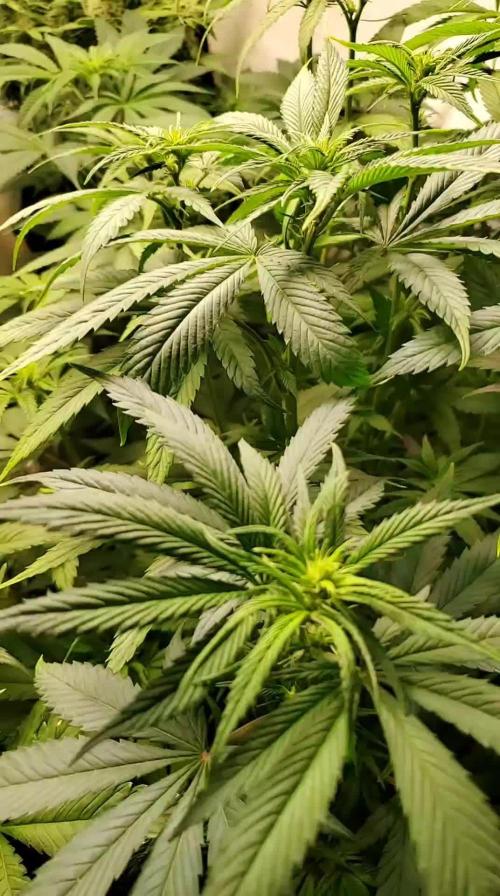The Grow Awards 2026 🏆 

































Likes
Comments
Share


@Xpie77
Follow
Verslag derde week bloei – Purple Punch
De derde week van de bloeifase bij Purple Punch is een cruciale periode waarin de planten een aanzienlijke ontwikkeling doormaken. Hieronder vind je een overzicht van wat je kan verwachten
1. Plantengroei
Bloemvorming: De eerste tekenen van echte toppen worden zichtbaar. De bloemkelken beginnen op te zwellen en trichomen ontwikkelen zich.
Stretch: De planten zijn nog steeds bezig met hun "stretch"-fase. Dit is vaak het laatste moment waarin ze aanzienlijk in hoogte groeien. Zorg dat de afstand tot de lamp optimaal blijft om verbranding te voorkomen.
2. Verzorging en voeding
Voedingsschema:
Fosfor- en kaliumrijke voeding (PK-boosters) wordt belangrijker om de bloemontwikkeling te ondersteunen.
Blijf stikstof in balans houden; te veel kan de bloei vertragen.
pH-waarden: Houd de pH van het voedingswater rond de 6.0 voor optimale opname.
Watergift: Regelmatig water geven, maar voorkom overbewatering.
3. Licht en temperatuur
Lichtcyclus: Houd de cyclus op 12/12 uur. Controleer dat er geen lichtlekken zijn tijdens de donkere periode.
Temperatuur en luchtvochtigheid:
Dag: 22-26°C.
Nacht: 18-21°C.
Luchtvochtigheid: 40-50%. Een te hoge luchtvochtigheid kan schimmelvorming veroorzaken.
4. Controle en monitoring
Trichomen: Begin de ontwikkeling van trichomen te monitoren. De toppen zullen meer glinsteren naarmate ze rijpen.
Plagen en schimmels: Inspecteer de planten regelmatig op tekenen van plagen, zoals spintmijten of meeldauw.
Luchtcirculatie: Zorg voor goede ventilatie om hotspots te vermijden.
Resultaten derde week
De toppen van Purple Punch zouden nu meer volume moeten krijgen en de kenmerkende fruitige aroma's beginnen zich te ontwikkelen. Dit is het moment waarop de genetische kwaliteiten van de soort echt naar voren komsn
Likes
19
Share


@GoldenWeedGrower
Follow
Legend
Timestamp: 📅
Measures: 🛠️
Water: 🌊
Actions: 💼
Thoughts: 🧠
Events: 🚀
________________________________
📅 D36/V34 - 28/09/23
🛠️
🌊
💼 New LST - Made Timelapse of the grow
🧠
🚀
________________________________
📅 D37/V35 - 29/09/23 -
🛠️
🌊
💼 LST on the younger lady.
🧠
🚀 Marlene Senior is pre-flowering
________________________________
📅 D38/V36 - 30/09/23
🛠️ EC raised to 1.2 pH is stable to 6
🌊 Added 5L and nutes
💼
🧠
🚀
________________________________
📅 D39/V37 - 01/10/23
🛠️
🌊
💼 LST again on the younger and HST on her main bud
🧠 The bigger one is ok for now, I'm going to let her grow normally a little bit
🚀
________________________________
📅 D40/F01 - 02/10/23
🛠️
🌊 Added 2L water and nutes
💼 LST on Marlene Junior and a little bit on the older as well
🧠
🚀
________________________________
📅 D41/F02 - 03/10/23
🛠️ EC and pH are both stable
🌊 Added water 2L
💼 Made timelapse of the last nights
🧠 She's drinking a lot, I need to understand how to manage the flowering stage
🚀
________________________________
📅 D42/F03 - 04/10/23 -
🛠️
🌊
💼 Big Defolation and strong LST
🧠 Maybe the last training before full flowering stage
🚀
Likes
181
Share


@GODSGIFT_2005_JM
Follow
🍼Greenhouse Feeding BioGrow & Bio Bloom
🌱GARDEN OF GREEN SEEDS
⛺️MARSHYDRO
The ⛺️ has a small door 🚪 on the sides which is useful for mid section groom room work. 🤩
☀️ by VIPARSPECTRA (models: P2000 & XS 2000)
Likes
28
Share


@Growthetics
Follow
Sorry for the late post had a very busy period. The buds are great, good feedback from patients.
First time I've been able to taste a fully organic bud and I can say I won't be going back!
Likes
12
Share


@Archieballs
Follow
The nutrient measurements are for week 7 this week they just got PH water at 2 liters. She’s a beautiful plant!!! Her colors are amazing!!! The inner part of the flower is like a deep blackberry color and the inner parts of the sugar leaves are as well. Amazing plant!!! I have 2 more beans of her and want to do one in a 5 gallon and see how she does just don’t have the space at the minute. She will get one more feeding in 3 days time and then on to her flush.
Likes
4
Share


@Elguacho420
Follow
Muy buenas a tod@s!!! Bueno arrancamos con las semanas de floración para esta pricodelicia, de momento se ve bien, creciendo tranquilamente, mas q alguna que marca falta de nutrientes( fallo mío, perdón) va creciendo bien y fuertes, hay buena recompensa está vez, ojalá, ya veremos, de momento ampliamos la gama de advanced que me parece genial, así q vamos a probar q tal funcióna y los resultados q da... Vamos a ver q tal sigue esta semana... Un saludos y buenos humos para tod@s! 💨💨🔥🔥👍🏻👍🏻
😎💎⚕️
🇦🇷🤝🏻🇪🇦
Likes
19
Share


@GuerillaSweed
Follow
Did some defoliation 3-4days earlyer 🤘🏾 looking good, no bugparty or any mold (yet)🤪
Waterd them with the good good n we out 🤘🏾
Likes
37
Share


@MrJones
Follow
OSS Ghost Train Power
🔹⊱╮🔹╰⊰🔹 GROW Started 03.10.24 INFORMATION 🔹╰⊰´🔹⊱╮🔹
🌞Environment - Maintaining 80F and 65%Humidity
🌾Training - Nothing this week just letting the seedlings veg out.
⚱️2-Gallon 📊6.2 PH
💧 Feeding - Using Horti Grow 8-11-21, Bloom 5-15-26, Late Bloom 0-24-26, Cal 12-0-0
🌞Medic Grow Smart 8 760 Watts
🕷️ IPM - CannControl from Mammoth and Mosquito Bits as needed
🔹⊱╮🔹╰⊰🔹 PLANT UPDATES 🔹╰⊰´🔹⊱╮🔹
📝 Notes - These girls have completely transformed into their new buckets and have started to drink up, increasing the amount of fertigation, (Nutrients and H20), and defoliation to expose the lower growth.
🗓️03.29.24 Maintaining Temps and Humidity - Plants are Looking Great!
🗓️03.30.24 Today fed with Hort-Grow @ 3.3 GRMS Per Gal, and Horti-Cal @ 2.5 GRMS Per Gal. I defoliated the plants to water them better and the middle growth could get more light and develop.
🗓️03.31.24 Maintaining Temps and Humidity
🗓️04.01.24 Today fed with Hort-Grow @ 3.3 GRMS Per Gal, and Horti-Cal @ 2.5 GRMS Per Gal. Check out the amazing growth and recovery after the defoliation!
🗓️04.02.24 Maintaining Temps and Humidity, watching these ladies are just nailing the veg phase.
🗓️04.03.24 Today fed with Hort-Grow @ 3.3 GRMS Per Gal, and Horti-Cal @ 2.5 GRMS Per Gal
🗓️04.04.24 Maintaining Temps and Humidity, closing out week 2 of veg and these ladies will need to be defoliated again, this new nutrient line from Greenpnaet is killing it, and so easy to use!
╰⊰🔹╰⊰´🔹⊱╮🔹╰⊰🔹╰⊰🔹STRAIN INFORMATION🔹⊱╮🔹╰⊰🔹╰⊰🔹╰⊰🔹⊱╮
Powerful West Coast genetics Ghost Train Haze x Pellezino combine to create this exceptional Cali weed strain Ghost Train Power. This exceptional strain exhibits dominant terpenes like Limonene, Linalool, and Terpinolene that produce a tempting citrus, herbal, floral scent with a fruity taste that is a flavor sensation.
Ghost Train Power comes from powerhouse parentage and produces extreme levels of THC up to and in excess of 30% and when you consider her substantial production this strain is unprecedented. The potent effects are surreal and intoxicating and the harvests are a treat. Indoors this beauty will reward you with a generous 650 gr m2 of tantalizing frosted bud and outdoors she can produce more than 1 kilo per plant. Ghost Train Power is USA genetics that will live up to its acclaimed reputation and have you coming back for more over and over again.
Likes
14
Share


@fivegrow
Follow
Top leaves are turning yellow probably due to excess light and heat. Temperatures are very high above 30oC in southeastern Brazil. I increased the lighting distance 30cm from the top. QB LM301H 120W
Likes
16
Share


@AestheticGenetics
Follow
4/9/25
This plant is beyond frosty. Stacking up super nicely. Seems like she will yeild quite a bit.
My only gripe is that she has like no smell at all.
Using the foil as a soil cover is working quite nicely. the top soil is getting filled with roots quite well.
Top dressed 1tsp of Bloom
1tsp microbe charge
1tsp bloom
Likes
4
Share


@efectocanario
Follow
comenzamos la primera semana de floracion, y junto con el formamos el primer super cropping en las fotos principales podemos apreciar el momento en que hacemos el super cropping y podemos comparar con la siguiente foto es al otro dia cuando sale el sol y vemos como las hojas enseguida se posicionan para absorver todo los rayos solares posibles! tambien comenzamos con las bases de floracion y durante las 2 primeras semanas de flora agregamos voodo juice y bud ignitor
Likes
17
Share


@Ieiogrow94
Follow
Eccoci alla fine!!!
Pianta dall’odore spaziale nel pulirla mi ha sballato! Super compatta e molto molto resinosa 💚
Sicuramente verrà riprovata in vaso più grande in quanto ha davvero un potenziale immenso, gradita veramente molto!
Grazie a tutti per il supporto ❤️🔥🌲
E grazie a @Exotic_Seed per la collaborazione ❤️
Processing
Likes
7
Share


@DigitalJockeyKing
Follow
got bitten by a spider and realized i was always wondering what my spiritual animal was, and realized it was spiders after that awakening of asking mother natures help me and spiders made a blood pack and since then nature has been helping me out by protecting my plants, from thieves and bad rotten people. and nature gave me spiders to protect my children. one of my spiders thats protecting the rooibaard is called GREGGK.
Processing
Likes
142
Share


@MadeInGermany
Follow
Hey everyone :-)
This week it smells more and more sweet and fruity in the whole room 😍.
There is actually not much to report, everyone is now under 12/12 :-).
This is the last grow that comes in the entire diary.
From now on, each plant will be added to the diary 👍.
I wish you all a lot of fun watching, stay healthy 🙏🏻 and let it grow 😎👌
Likes
8
Share


@Hawkbo
Follow
Pics taken on day 42 and video day 43. The 3 in the 1 gallon pots are shown at the end of the video they are off to the side.
Likes
241
Share


@Still_Smoq
Follow
📆 Week 18, 21-27 May 2024
21-27 May - Observed and let the plant mature.
📑 At this point in the grow there is nothing much left to do except observe the plant and let it finish maturing. Although the bud size is somewhat smaller than anticipated, they appear tight and very uniform. The trichomes overall are 80% milky/10% amber/10% clear. Almost all pistil hairs are dark, and her smell has peaked with a sweet pine, gas, fruity scent. This was the last week of flower and she’s ready for the final week of flush and harvest.
🍶 21 May changed nutrient solution
🍽️ 21 May updated feeding schedule
💧 Using reverse osmosis water with EC/TDS at 0
🐉 Nutrient Solution EC .9 at 70 degree F
🔆 Light power: one at 75%, and one at 50%, DLI 35-40 canopy coverage at 12hrs
😤 Using General Hydroponics, HGC728040, Dual Diaphragm Air Pump, 320 GPH
That is it for this week. Thanks for the look, read and stopping by.
Likes
41
Share


@UnorthadoxDude
Follow
Hello and welcome to week three for Enigma.
Day 15: She is a bit sad today. I dropped her yesterday she took quite a jolt, and I think I overwatered her, so I upended her and waited until some drips came out, and then stuck a straw down to the bottom of the pot and blew air into the medium. She became a little less droopy within an hour of that, I am keeping an eye on her. It is going to be really hard to manage feeding her without over-watering her. I have certainly set myself a real challenge with this pot.
Day 16: Enigma is hungry but over hydrated. The only thing I can think to try is making a special extra-strong nutes just for her.
Day 18: Starting to find the balance of moisture. This is not easy at all.
Day 19: Decent bit of growth today. Overall this lady is showing strong signs of being severely restricted by the pot size. No training at all intended, let's just see what happens.
Day 20.5: She's perked up quite a bit since the photo. My extra strong nute regime seems to be paying off. She is maintaining a narrow form I am starting to wonder if roots act a bit like a cats whiskers? A cat's whiskers grow to the width of the cat's widest part... and they use them to know if they will fit through something. In observing these various cannabis plants, I am beginning to notice a correlation between plant width and pot width. This is bolstered by the evidence of transplanted plants rapidly stretching in width when introduced to a much wider pot.
If my working theory has any basis in reality then an optimal pot would be short and fat rather than tall and narrow. I am probably going to test this theory with some clones.
A second note of interest pertains to the quick shockingly rapid growth of both Misty and Nesia. These plants are even way ahead of where Citronella was, and I have been consistently delighted with Her Majesty. Is it simply starting them in bigger pots from seed? That has some impact I'm sure. Nevertheless I feel not enough impact to explain the massive difference. I think it's the nutes. Time for an admission, I have been being very lazy with the fertigation. I mix up 10l of nutes based on the stated dosages for the eldest plant (Karen)....and then I feed all of the plants with this even the ones that are much younger. So both Misty and Nesia got nutes for a plant in week 4 from seed and each week they increased. Could it be that the key to organic nutes in coco is to massively over-nute? Hmmmmmmmmmmm.
Day 21: Weekly summary: some problems early this week but corrected and she's much happier today.





















